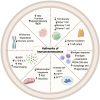The 3 I's of immunity and aging: immunosenescence, inflammaging, and immune resilience
- PMID: 39478807
- PMCID: PMC11521913
- DOI: 10.3389/fragi.2024.1490302
The 3 I's of immunity and aging: immunosenescence, inflammaging, and immune resilience
Abstract
As we age, our immune system's ability to effectively respond to pathogens declines, a phenomenon known as immunosenescence. This age-related deterioration affects both innate and adaptive immunity, compromising immune function and leading to chronic inflammation that accelerates aging. Immunosenescence is characterized by alterations in immune cell populations and impaired functionality, resulting in increased susceptibility to infections, diminished vaccine efficacy, and higher prevalence of age-related diseases. Chronic low-grade inflammation further exacerbates these issues, contributing to a decline in overall health and resilience. This review delves into the characteristics of immunosenescence and examines the various intrinsic and extrinsic factors contributing to immune aging and how the hallmarks of aging and cell fates can play a crucial role in this process. Additionally, it discusses the impact of sex, age, social determinants, and gut microbiota health on immune aging, illustrating the complex interplay of these factors in altering immune function. Furthermore, the concept of immune resilience is explored, focusing on the metrics for assessing immune health and identifying strategies to enhance immune function. These strategies include lifestyle interventions such as diet, regular physical activity, stress management, and the use of gerotherapeutics and other approaches. Understanding and mitigating the effects of immunosenescence are crucial for developing interventions that support robust immune responses in aged individuals.
Keywords: cellular senescence; immune resilience; immunosenescence; inflammaging; inflammation.
Copyright © 2024 Wrona, Ghosh, Coll, Chun and Yousefzadeh.
Conflict of interest statement
The authors declare that the research was conducted in the absence of any commercial or financial relationships that could be construed as a potential conflict of interest. The author(s) declared that they were an editorial board member of Frontiers, at the time of submission. This had no impact on the peer review process and the final decision.
Figures




References
-
- Adlowitz D. G., Barnard J., Biear J. N., Cistrone C., Owen T., Wang W., et al. (2015). Expansion of activated peripheral blood memory B cells in rheumatoid arthritis, impact of B cell depletion therapy, and biomarkers of response. PLoS One 10, e0128269. 10.1371/journal.pone.0128269 - DOI - PMC - PubMed
Publication types
LinkOut - more resources
Full Text Sources
Research Materials

